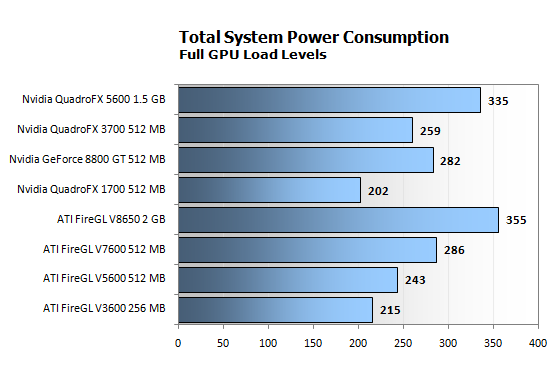NVIDIA QuadroFX 3700 512 MB
The cooling system features a copper baseplate which connects directly to the GPU and works in conjunction with a series of aluminum alloy thin-fins to dissipate heat away from the core and memory chips. The cooler features an embedded 70mm cooling fan, which connects to the board via a 4-pin PWM power connector, allowing for smooth fan speed transitions. The "cover" of the card is made from aluminum alloy as well, which helps route airflow over the heatsink, but also helps dissipate heat itself. It’s also got a snazzy NVIDIA logo on top, which allows you to see it’s an NVIDIA card whilst installed in the system – a nice touch.
As for the cooling system itself, it’s quite effective at keeping the G92 cool while keeping noise levels down. Since the G92 runs at a lower clock speed compared to what these cooling systems are used to dealing with on the 8800 GT series, the cooling system is able to keep temperatures in check, rarely going out of its lowest fan state.
When the card is sitting idle, clock speeds will drop from 500 MHz (GPU) / 1.6 GHz (GDDR3) to 300 MHz (GPU) / 200 MHz (GDDR3), which cuts power consumption by a significant amount and also allows the GPU to run at temperatures of about 37°C (98°F). At this level, the QuadroFX 3700’s fan runs at 30% (~1600 RPM) and was more or less inaudible.
When you throw heavy GPU processing loads at the board, power consumption and heat levels increase by quite a bit, although this doesn’t necessarily lead to higher noise levels. Over a prolonged period of GPU stress testing, our GPU hit peak thermal levels of 67°C (152°F). At this temperature, our 3700’s fan was only running at 34% (~1850 RPM) and was still keeping the GPU cool. We did not see the fan speed jump beyond this level, as the slight extra boost in fan power was able to keep the GPU within a nominal temp range. All told the QuadroFX has a simple, quiet, and effective cooling system which we appreciate.
Idle Clocks and Temperatures |
 Full GPU Load Clocks and Temperatures |
The QuadroFX 3700 card runs pretty cool and quiet – which bodes well for overall power consumption tests. NVIDIA’s G92 architecture is a far more efficient design compared to their monster G80 architecture featured on the QuadroFX 5600. So even before testing, we were expecting substantial reductions in power consumption.
As always, our systems are tested on identical platforms (specs on the next page) with just the graphics cards swapped out. Levels are taken from a hardware AC wattage monitor during idling at the Windows desktop and with a full GPU load designed to hit peak GPU power consumption levels. Let’s see the results.
|


As expected, the QuadroFX 3700 consumes substantially less compared to NVIDIA’s ultra-high-end QuadroFX 5600 card, to the tune of about 30W when idling and around 80W during full GPU load. It’s also interesting to see that the QuadroFX 3700 consumes less power compared to our 8800 GT card, which is based on the same architecture but runs at slightly higher clock speeds compared to the 3700 card. All in all, these are very nice power consumption numbers considering the specifications and raw rendering power this card provides.






